Spring care for an apple tree in the country: what to do in an apple orchard after winter
Most of the work in the apple orchard must be carried out in the spring, in order to lay the foundation for the full development and abundant fruiting of apple trees this season immediately after winter.
Next, you will receive all the information you need regarding spring apple tree care activities, thanks to which you can get a decent harvest.
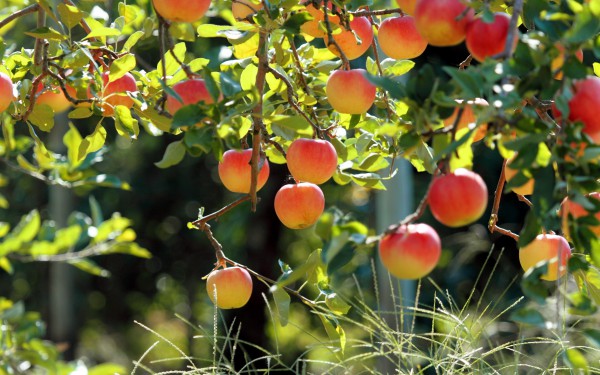
Content
- 1 Apple tree care in spring: basic work
- 1.1 Removing a winter protective shelter from young seedlings
- 1.2 Treatment of trees in cases of damage by rodents in winter
- 1.3 Whitewash
- 1.4 Spring pruning
- 1.5 Bending branches to stimulate fruiting
- 1.6 Protective treatment against pests and diseases
- 1.7 Watering, loosening and mulching
- 1.8 Top dressing and fertilization
- 2 Other care activities you can do in the spring in the apple orchard
Apple tree care in spring: basic work
At the end of winter, the apple tree should be provided with everything necessary for normal growth and development.
Advice! If your the apple tree does not bloom well and / or bears fruit, then you will find the possible reasons for such a sad phenomenon in this article.
Removing a winter protective shelter from young seedlings
After the snow melts on the site and the soil freezes, in other words, a stable above-zero temperature is established, it will be possible to remove the protective tapes (or similar devices), which were wrapped around the lower part of the trunk of a young apple tree sapling in the fall to protect against rodents (mice and hares) and from sunburn (instead of whitewashing).
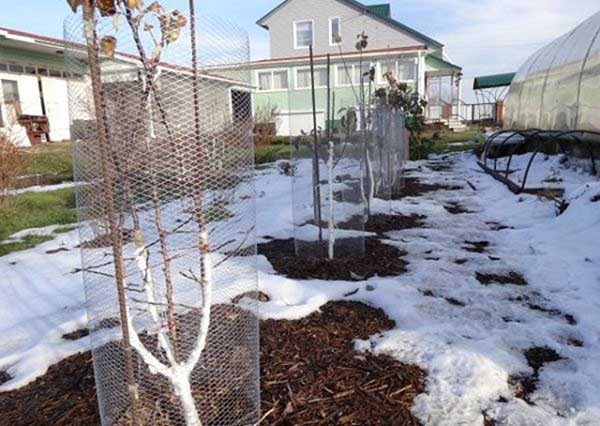
However!Just take your time! If you remove the tape ahead of time, then the tender young bark can get sunburn (cracked).
If you've used the correct breathable (non-woven) fabric, then nothing underneath will stick.
Treatment of trees in cases of damage by rodents in winter
If you have neglected the recommendation for creating a winter protective shelter from rodents and as a result, they have seriously damaged the bark in the lower part of the trunk, so to speak, gnawed with a ring, then to save the tree, you canto plant an apple tree with a bridge.
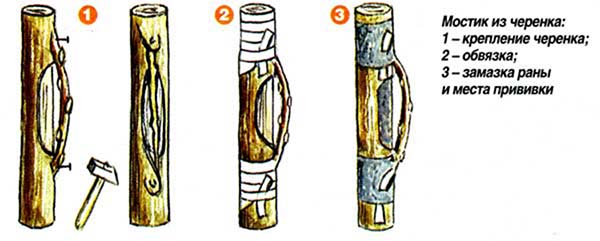
Note! Bridge inoculation is performed only when ring damage, in other cases (even if there is even a small isthmus of the bark) you just need to cover the bare trunk with garden pitch.
Whitewash
In fact, you always need to whitewash trees. in the fall, and in the spring only to correct the result, for example, if the whitewash is washed off or badly peeled off during the winter. That is why spring whitewashing is also called repeated or renewingbut no way not main.
Of course, if for some reason you did not do this last year, then it is better to do it now, that is, to whitewash it in the spring.
However! Please note that this will only make sense if you whitewash the trees in late winter-early spring, i.e. in February-March, since it is during this period that cracking of the bark can occur.
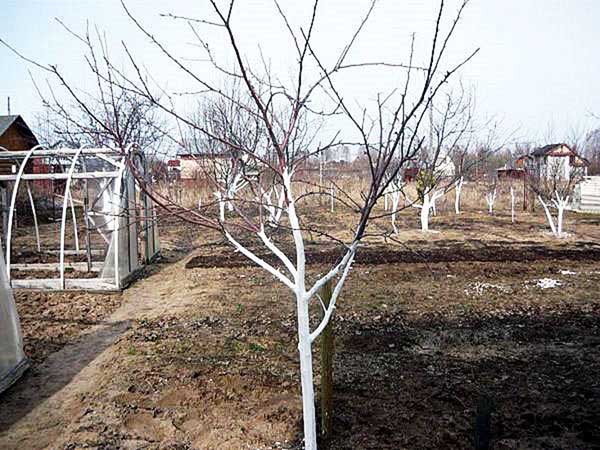
By the way! The site has a detailed article about when and how to whitewash trees in the garden.
Spring pruning
Early spring is the best time to prune all fruit trees, including apple trees, and pears, peaches, apricots and others (although it is pome crops - apples and pears that can crop in autumn, but it is still preferable to do this in the spring).
The first step is sanitary pruning. Namely, you need to remove all broken and dry branches that have not survived the winter. And already further:
- Continue form young seedlings in order to create a crown of the correct (chosen by you) shape (formative pruning).
- As for mature trees that have been bearing fruit for a long time (including old and overgrown ones), they will need such types of pruning as thinning, stimulating and rejuvenating.
More about how to prune old and young apple trees in spring, read in this material.
Video: spring pruning of an apple tree in detail
Bending branches to stimulate fruiting
The meaning of this technique (changing the angle of inclination of the branch) is to slow down the growth of branches in length and at the same time increase the number of awakened buds, from which fruit branches will then grow. As a result, a young tree will be able to start bearing fruit earlier, while an older tree will be more abundant.
- When and how to bend down?
In the spring, when the buds begin to swell (i.e., after the start of sap flow), you will need to bring the branches to the maximum horizontal position (the angle should be more than 45 degrees, preferably closer to 60 degrees).
This can be done in 2 ways:
- pull the branches down and secure them with twine (linen thread) to the main tree trunk (not the best option);
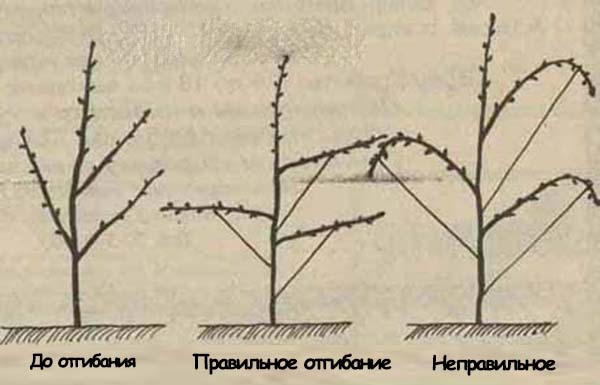
- or tie it to pegs in the ground (optimal).
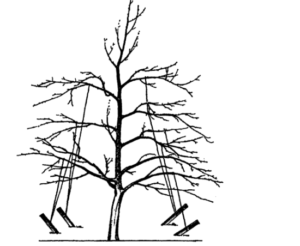
Advice! Better exactly tie branches to pegs driven into the ground than to a trunk... The fact is that in this case the ropes will pinch and injure the tree trunk and, as a result, may even grow into it (if you forget to remove it).
In other words, this method is much safer and looks much neater.
- When to remove the ropes?
Closer to autumnwhen the branches take the necessary (inclined) position, you will need them untie in timeso that no constrictions form or, even worse, the rope does not grow into the trunk.
Note! In fact, this procedure is not so important for the apple tree (since the crop can bear fruit on branches with an angle of less than 45 degrees), as really essential for pear.
Protective treatment against pests and diseases
Every year you need to timely carry out comprehensive preventive and therapeutic spraying of the apple tree against diseases and pests during the entire growing season, i.e. in spring, summer and autumn.
So, the most common fungal diseases affecting the apple tree are:
- moniliosis or monilial rot (apples rot right on the tree);
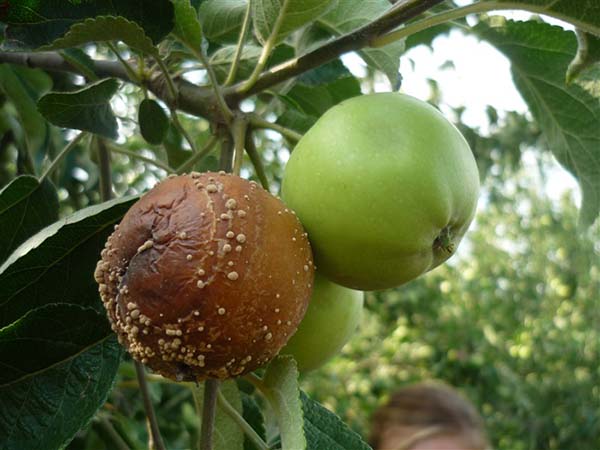
- scab.
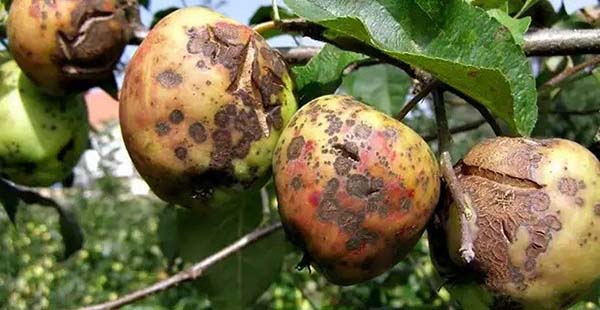
Naturally, pests also attack the apple tree (flower beetle weevil, apple moth, aphids, sawfly, ticks, etc.).
By the way! If on your apple trees aphid attacked, then in the fight against this malicious pest of fruit trees you can to help this material.
To protect the apple tree from diseases and pests, it is worth carrying out several timely preventive spraying:
- So, the first processing of an apple orchard is carried out even along bare branches (before the buds begin to swell), carrying out early spring eradication spraying.
- Then, several sprays are made at certain stages of culture development ("green cone", "pink bud", "pea-sized ovary").
By the way! The site has a detailed article about how to properly spray an apple tree from diseases and pests in spring.
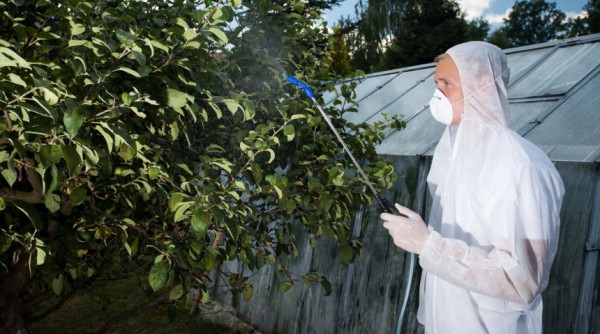
- And before wintering they also spend now autumn eradication treatment.
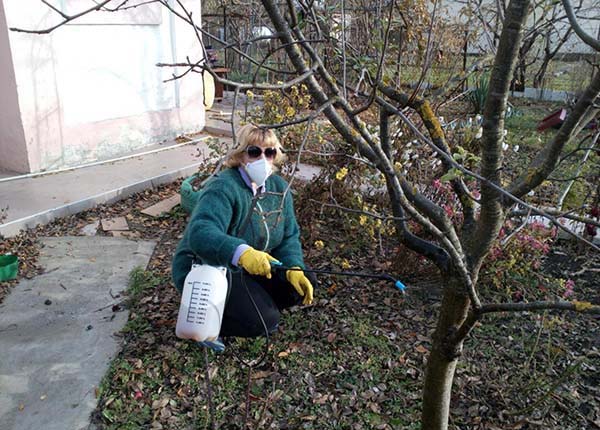
Watering, loosening and mulching
First of all, you should start by loosening the trunk circle, the earth in which has compacted during the winter, in order to provide full access of air and nutrient moisture to the root system. In addition, digging will get rid of some of the wintering pests and pathogens (fungal spores).
As a rule, if the winter was snowy, then in the spring the land is usually quite well moistened, which means that you will not need any additional watering from you.
However! It should be borne in mind that before flowering and after setting the fruit, the apple tree must be completely provided with moisture.
At the same time, the soil should not be allowed to dry out, but it should not be poured (especially waterlogging is harmful at the end of the growing season - August, since it delays the ripening of annual shoots, and the plants do not have time to prepare for winter).
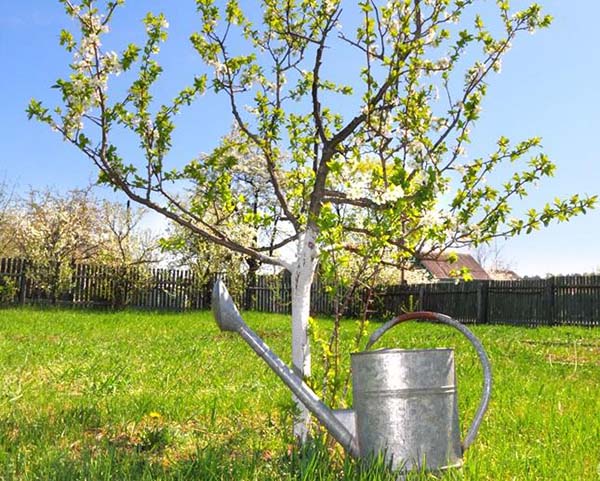
If you do not want to after each watering earthen crust formed, then the tree trunk circle of the apple tree should be mulched, for example, with the same peat, compost, humus, sawdust or bark. Mulch will also prevent rapid evaporation of moisture and the formation of weeds. Only do not pour mulch close to the trunk! This can cause the bark to undergo.
Advice! Loose before watering and then mulch the tree circle.
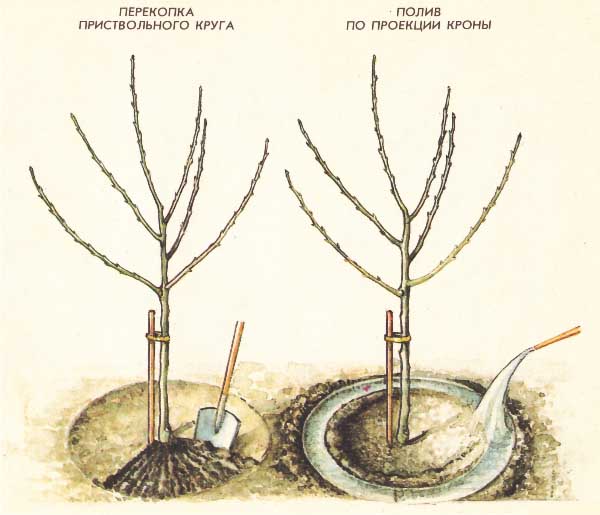
Top dressing and fertilization
In order for the apple tree to quickly recover and grow after winter, you need to carry out several timely dressings.
Important! More information about how and what to fertilize apple trees in spring and summer, you'll find in this article about feeding an apple tree.
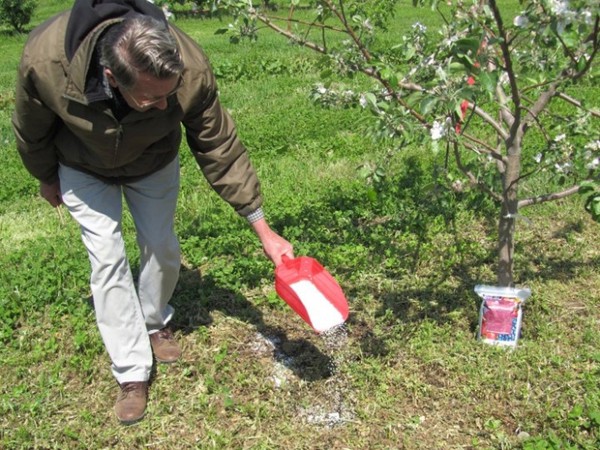
As a rule, apple trees are fed according to the following scheme:
- in early spring (it is possible even in the snow) - most often they are used purely nitrogen fertilizers (optimally -ammonium nitrate) or complex fertilizers (such as nitroammofosk) or their organic analogues - infusion of mullein, poultry droppings;
- before flowering - potassium-phosphorus fertilizers (more potassium);
- during flowering (under adverse weather conditions) - boron (foliar top dressing);
- after flowering and the formation of ovaries - again potassium-phosphorus fertilizers (again, more potassium) + foliar dressing with microelements (magnesium, manganese, iron, calcium);
Advice! If you have already contributed phosphate fertilizers last year (autumn) then in the spring, before and after flowering, can be used only potash, for example, potassium sulfate or wood ash.
- after fruiting (in autumn) - phosphorus-potassium fertilizing.
By the way! The site also has a separate article about the autumn feeding of the apple tree.
Other care activities you can do in the spring in the apple orchard
Protection against returnable spring frosts
Late frosts can damage already opened flower buds.
There are 2 ways to protect apple trees from the negative effects of subzero temperatures:
- Smoke, namely, with the help of smoke from a smoldering fire, you will need to increase the air temperature.
However! The method is effective only under the condition of weak frosts (up to -4 degrees).

- Sprinkling... The point is to spray the trees with water from a hose (spray) shortly before frost (preferably at night).
Please note! Unfortunately, if the weather is windy, the effect will be the opposite.

If you did not manage to do anything, but there was frost and the apple trees did not bloom, then try to spend bark furrowin other words, make vertical cuts in the bark to the wood with a length of 5-7 centimeters with a garden knife.
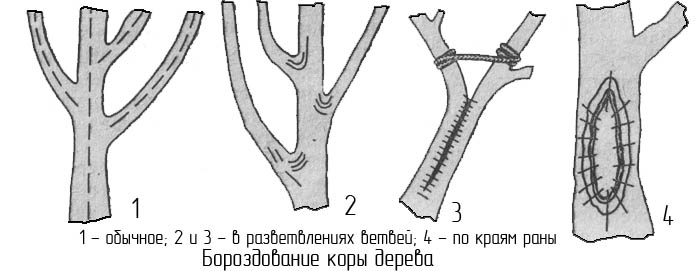
Spring grafting
What can force a gardener to resort to this procedure, or why plant an apple tree:
- There is a desire to cultivate a wildflower that has grown from seeds on your site by grafting a varietal tree on it.
- For some reason, you are not satisfied with the previously planted variety, and you want to re-graft it to a more suitable one.
- Want to experiment and try to grow several varieties at once on the same tree.
Note! The site already has detailed material about how to plant an apple tree, which disassembled all the main ways of grafting a fruit tree.
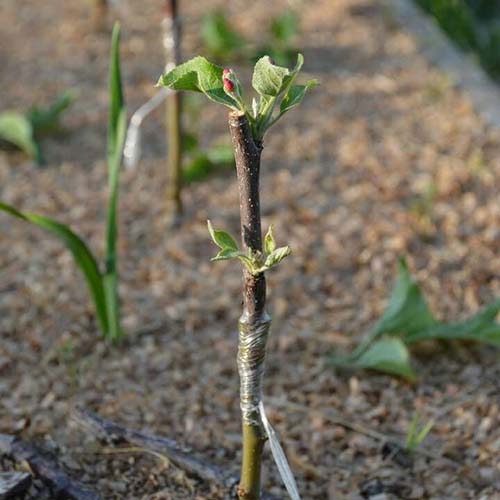
Transplanting and planting seedlings
If you planted the apple tree in the wrong place, then spring is a great time to transplant the seedling to another place. In this case, your main task is to preserve the earthen lump without fail. Then the seedling will hardly experience stress and easily adapts to new conditions.
Of course, in spring you can embroider your apple plantings by planting another seedling.
And about that how to plant an apple tree in spring — read here.
Video: how to transplant a fruit tree correctly
Take care of your apple orchards properly, good luck!
And do not forget that full care of the apple tree must be carried out not only in spring and summer, but also in the fall to properly prepare the tree for winter.


Super, I love your articles !!!! Simple, clear, accessible))))